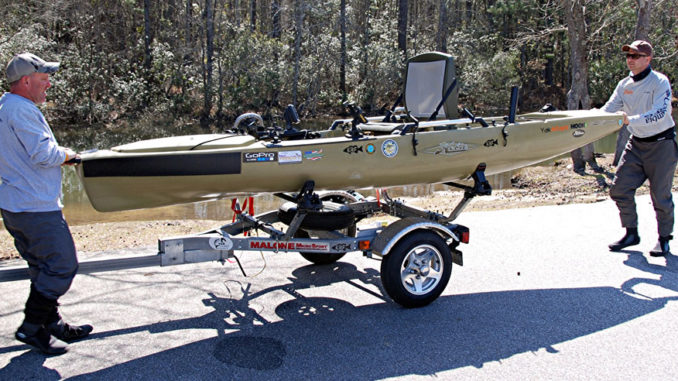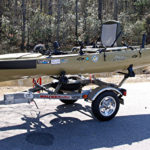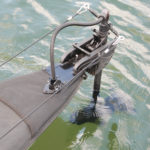
Less is more for kayak anglers. Or is it?
In the kayak-fishing industry, most die-hard paddling anglers can trace their roots back about 10 years. The old-school anglers have been around about 15 years, and the true pioneers of the sport may boast 20 years. To put that into perspective, very few of us launched our kayaks to get away from it all to ponder and meditate on the impending doom of Y2K.
Most kayak anglers get into the sport for one of three major reasons: they are on their way up in the fishing experience; they are on their way down; or, like Goldilocks, they found that fishing from a plastic boat suited their interests and needs just right.
With all the hustle and bustle to design and create new “stuff” for a sport that originally braced the “less-is-more” mantra, the question arises: “Has kayak fishing gotten away from it’s roots?”
The best way to answer is by an observation of what is considered “normal” for the kayak-fishing community.
Kayak trailers hit the market in the past 10 years as a way for the gas-conscious, economy-sized automobile paddlers to transport a boat behind a vehicle that didn’t have eight cylinders.
Once upon a time, the only folks interested in carrying more than two boats were river outfitters making put-in and take-out runs. Today, it is not uncommon to see kayakers retrofitting powerboat trailers to carry just one boat as the boats get bigger, heavier and are equipped with as much gear as a glitter-rocket fiberglass boat. Gone, it seems, are the days of true car-topping a kayak on a rack or throwing it in the bed of a pickup with a couple of rods and a paddle.
Speaking of gear, today’s Tupperware fleet, fully involved, includes the same, big-screen sonar monitors found on every metal-flake BASS- or FLW-inspired fishing vessel. Add to that list power-pole type anchoring systems, battery power plants, rod holders and adjustable seating.
It’s interesting to note that seats were originally designed to flip down so that the boat could be rolled over on its top or side for transporting or dumping water out at periodic intervals during a day of fishing. Today’s rigs rarely leave the standard top-up, bottom-down position based on both the weight and balance of the boat and to accommodate all the attached gear, even while in transit.
To get a good gauge of how much equipment comes attached, back in the day, it was commonplace to practice rolling the boat so that in the event a kayaker did take a spill, he or she would be prepared and know how to roll the boat back upright and continue fishing.
Today, rolling a boat means calling your local insurance agent to file a claim for the amount of gear that’s been ruined or lost. The inventory list might include more than a dozen rods and reels, various electronics that cost more than the boat itself, and scads of other accessory gear.
Having discussed that many car-top boats no longer car-top but ride secured to a trailer, the venues for launching kayaks have now been relegated to using the same public-launch facilities designed for and mostly over-crowded with power boats.
How many kayakers remember the days of driving across a secluded waterway and thinking to themselves, “I can park the car right over there and drag the boat through that little wooded patch or across those reeds and within minutes be pitching a bait at that big largemouth bass or a pod of over-slot redfish that have never seen a bait in this remote area?”
Today, you get in line with the other trailer boats, slide the yak off the end of the ramp and then paddle like mad to get out of the way of the pontoon boat full of weekend ramp warriors — with kids and picnic baskets — that’s right on your six.
Having adopted trailer transport and other features associated with powerboats, the next change was the power plant. Electric motors for kayaks are not new to the industry or the paddling scene. Originally marketed so handicapped anglers wouldn’t be limited by their physical capabilities, electric motors are now more commonplace in kayak-fishing circles, defying the accepted genre of “paddle” boats.
The battle over propulsion started with several kayak manufacturers successfully transferring the mode of human power from the arms to the legs, allowing anglers to make course adjustments with a hand-controlled tiller. The battle raged on as built-in and attachable electric motors arrived on the scene. In the past year, several big kayak-fishing tournaments have dropped their long-standing prohibition of electric motors.
At the end of the day, there is no edict that trailers, depth finders, power poles, rod holders and storage racks — or even electric trolling motors — have to be used to enjoy a peaceful day on the water.
You could always just throw the yak on top of the car or in the back of the truck along with a paddle and a couple of fishing rods and just go fishing.






Be the first to comment